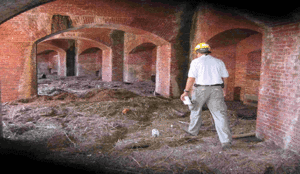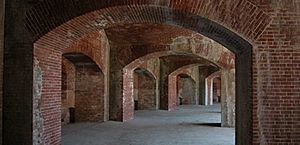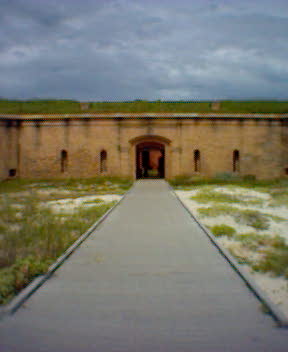Fort Massachusetts (Mississippi) facts for kids
Quick facts for kids |
|
|
Fort Massachusetts
|
|

Fort Massachusetts
|
|
| Lua error in Module:Location_map at line 420: attempt to index field 'wikibase' (a nil value). | |
| Nearest city | Gulfport, Mississippi |
|---|---|
| Area | 85 acres (34 ha) |
| Built | 1859 |
| NRHP reference No. | 71000067 |
| Added to NRHP | June 21, 1971 |
Fort Massachusetts is an old fort located on West Ship Island. This island is part of the Mississippi Gulf Coast in the United States. The fort was built after the War of 1812. Its brick walls were constructed between 1859 and 1866. It was used until 1903. Today, Fort Massachusetts is a popular historical spot for tourists. It's part of the Gulf Islands National Seashore. You can find the fort about halfway along the north shore of West Ship Island, close to where boats dock.
Contents
History of Fort Massachusetts
After the War of 1812, the U.S. War Department started planning many new forts. These forts were made of strong stone and brick. They were meant to protect the country's coasts. Ship Island was very important for defense. It had a natural deep-water harbor and was on a busy shipping route. This made it key for protecting New Orleans and the Gulf Coast.
In 1847, Ship Island became a military area for the U.S. government. Nine years later, Congress approved building a fort there.
Building the Fort
Workers chose a spot on the north shore of the island. It was about 500 feet (152 meters) from the island's west end. Construction of the fort began in June 1859. The Army Corps of Engineers oversaw the project. Most of the work was done by civilians. Sometimes, as many as 100 men worked there. They included carpenters, stonemasons, blacksmiths, and stonecutters. By early 1861, the fort's outside wall was 6 to 8 feet (1.8 to 2.4 meters) high.
The Civil War Years
In January 1861, Mississippi left the Union. It became the second state to join the Confederacy. One of the first war actions in Mississippi happened on Ship Island. An armed group of Mississippi militia took control of the island and the unfinished fort.
The militia soon left the island. It stayed empty until June 1861. Then, Confederate troops returned and set up several cannons. On July 9, the Union Navy ship USS Massachusetts came close to the Confederate guns. They exchanged cannon fire for about 20 minutes. Few people were hurt, and there was little damage on either side. This was the only direct battle involving Ship Island or the fort.
During the rest of summer 1861, Confederate soldiers worked to make the fort stronger. They used sandbags and timber to build up the walls. But in mid-September, they left the island.
Union military forces soon took over the island. Ship Island became a main base for the Union army. From here, they launched their successful attack to capture of New Orleans in spring 1862. As many as 18,000 U.S. troops were stationed on the island.
Life on the island was tough for many soldiers. More than 230 Union soldiers died on Ship Island during the Civil War. They were buried there. Later, many of their remains were moved to Chalmette National Cemetery near New Orleans.
Union forces continued to use Ship Island for the rest of the war (1862–1865). Union ships stopped there for repairs and to get supplies. The 1st Louisiana Native Guard was also stationed there. This was one of the first black regiments in the United States Army. They stayed on the island for almost three years.
Many buildings were constructed on the island during the war. These included a hospital, barracks, mess hall, and bakery. The Army Corps of Engineers also restarted building the fort in 1862. It was around this time that the fort was first called "Massachusetts." This was probably in honor of the USS Massachusetts ship. However, the fort was never officially given a name. Most official records just called it the "Fort on Ship Island."
The United States government was the only one to lay bricks for the fort. Before the Southern states left the Union (1859–1861), the Army got its bricks from Louisiana. After the U.S. regained control (1861–1862), bricks came from New England. They were shipped down the East Coast and around the Florida peninsula. After the war ended (1865), bricks were again bought from Louisiana. Even today, you can see different brick colors on the fort's walls. This shows where different types of bricks were used.
The Corps of Engineers worked on the fort until fall 1866. Then, it was given to a civilian caretaker named C.H. "Pop" Stone. His job was to keep the fort ready for use. After cannons were placed, a special sergeant was assigned to care for the fort's weapons. This sergeant eventually took over all responsibility for the fort's upkeep. The last sergeant left duty in 1903. After that, the Ship Island lighthouse keeper became the fort's caretaker.
Saving Fort Massachusetts

Fort Massachusetts was built right at the water's edge. Waves and salty air had badly damaged the old mortar. This was especially true around the northeast part of the fort. In the 1960s, people in Mississippi started a "Save the Fort" movement. This led to the creation of the Gulf Islands National Seashore. Unlike some lighthouses, Fort Massachusetts is made of tons of brick and concrete. It could not be moved to a safer spot.
One way to protect this historic landmark is through "Beach nourishment". This means adding sand to the beach. To save money, the National Park Service works with the U.S. Army Corps of Engineers. The Corps removes sand from ship channels. Then, they pump it towards the fort. This creates a sandy beach. The beach acts as a barrier, protecting the fort's walls from the sea water.
Also, workers from the Historic Preservation Training Center came in December 2001. They repaired, replaced, and reset the fort's brick walls. These walls had not been properly maintained since 1866.
![]() This article incorporates public domain material from websites or documents of the National Park Service.
This article incorporates public domain material from websites or documents of the National Park Service.



